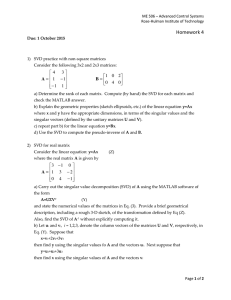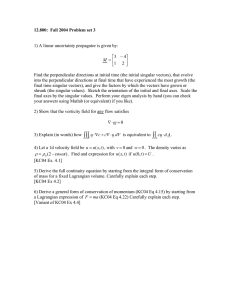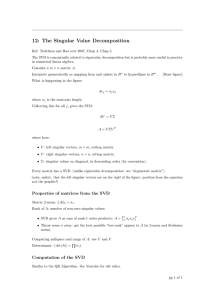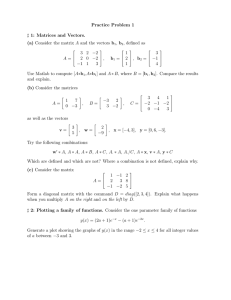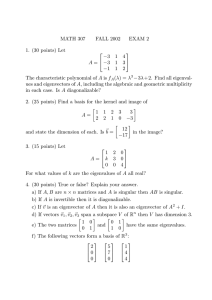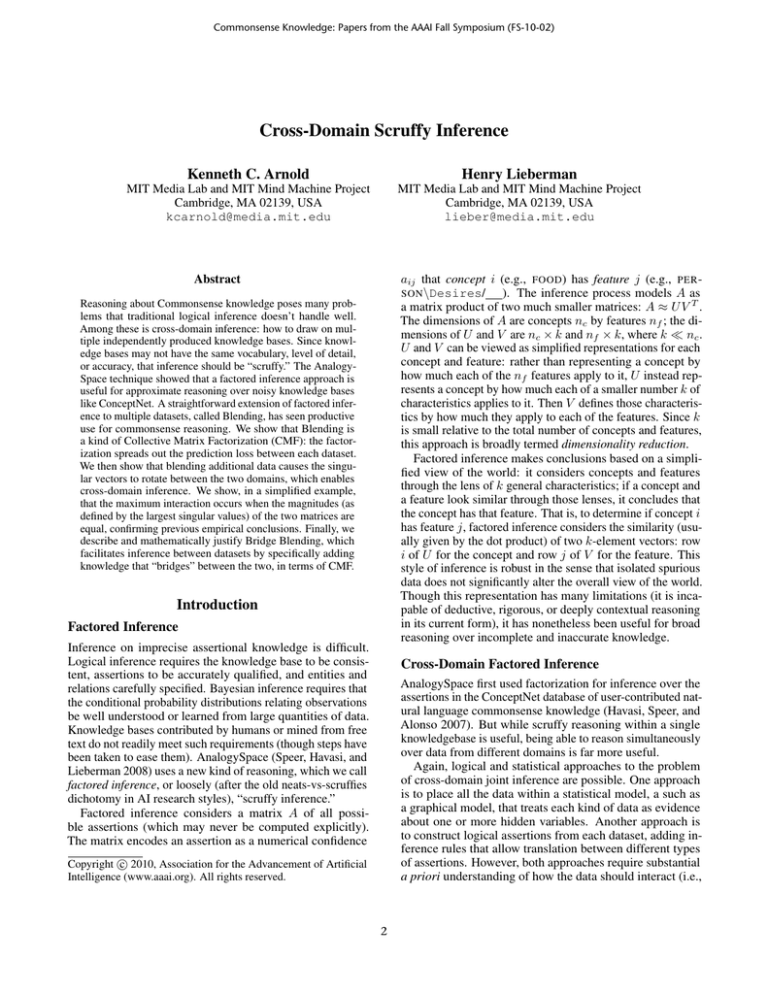
Commonsense Knowledge: Papers from the AAAI Fall Symposium (FS-10-02)
Cross-Domain Scruffy Inference
Kenneth C. Arnold
Henry Lieberman
MIT Media Lab and MIT Mind Machine Project
Cambridge, MA 02139, USA
kcarnold@media.mit.edu
MIT Media Lab and MIT Mind Machine Project
Cambridge, MA 02139, USA
lieber@media.mit.edu
aij that concept i (e.g., FOOD) has feature j (e.g., PER SON \Desires/
). The inference process models A as
a matrix product of two much smaller matrices: A ≈ U V T .
The dimensions of A are concepts nc by features nf ; the dimensions of U and V are nc × k and nf × k, where k nc .
U and V can be viewed as simplified representations for each
concept and feature: rather than representing a concept by
how much each of the nf features apply to it, U instead represents a concept by how much each of a smaller number k of
characteristics applies to it. Then V defines those characteristics by how much they apply to each of the features. Since k
is small relative to the total number of concepts and features,
this approach is broadly termed dimensionality reduction.
Factored inference makes conclusions based on a simplified view of the world: it considers concepts and features
through the lens of k general characteristics; if a concept and
a feature look similar through those lenses, it concludes that
the concept has that feature. That is, to determine if concept i
has feature j, factored inference considers the similarity (usually given by the dot product) of two k-element vectors: row
i of U for the concept and row j of V for the feature. This
style of inference is robust in the sense that isolated spurious
data does not significantly alter the overall view of the world.
Though this representation has many limitations (it is incapable of deductive, rigorous, or deeply contextual reasoning
in its current form), it has nonetheless been useful for broad
reasoning over incomplete and inaccurate knowledge.
Abstract
Reasoning about Commonsense knowledge poses many problems that traditional logical inference doesn’t handle well.
Among these is cross-domain inference: how to draw on multiple independently produced knowledge bases. Since knowledge bases may not have the same vocabulary, level of detail,
or accuracy, that inference should be “scruffy.” The AnalogySpace technique showed that a factored inference approach is
useful for approximate reasoning over noisy knowledge bases
like ConceptNet. A straightforward extension of factored inference to multiple datasets, called Blending, has seen productive
use for commonsense reasoning. We show that Blending is
a kind of Collective Matrix Factorization (CMF): the factorization spreads out the prediction loss between each dataset.
We then show that blending additional data causes the singular vectors to rotate between the two domains, which enables
cross-domain inference. We show, in a simplified example,
that the maximum interaction occurs when the magnitudes (as
defined by the largest singular values) of the two matrices are
equal, confirming previous empirical conclusions. Finally, we
describe and mathematically justify Bridge Blending, which
facilitates inference between datasets by specifically adding
knowledge that “bridges” between the two, in terms of CMF.
Introduction
Factored Inference
Inference on imprecise assertional knowledge is difficult.
Logical inference requires the knowledge base to be consistent, assertions to be accurately qualified, and entities and
relations carefully specified. Bayesian inference requires that
the conditional probability distributions relating observations
be well understood or learned from large quantities of data.
Knowledge bases contributed by humans or mined from free
text do not readily meet such requirements (though steps have
been taken to ease them). AnalogySpace (Speer, Havasi, and
Lieberman 2008) uses a new kind of reasoning, which we call
factored inference, or loosely (after the old neats-vs-scruffies
dichotomy in AI research styles), “scruffy inference.”
Factored inference considers a matrix A of all possible assertions (which may never be computed explicitly).
The matrix encodes an assertion as a numerical confidence
Cross-Domain Factored Inference
AnalogySpace first used factorization for inference over the
assertions in the ConceptNet database of user-contributed natural language commonsense knowledge (Havasi, Speer, and
Alonso 2007). But while scruffy reasoning within a single
knowledgebase is useful, being able to reason simultaneously
over data from different domains is far more useful.
Again, logical and statistical approaches to the problem
of cross-domain joint inference are possible. One approach
is to place all the data within a statistical model, a such as
a graphical model, that treats each kind of data as evidence
about one or more hidden variables. Another approach is
to construct logical assertions from each dataset, adding inference rules that allow translation between different types
of assertions. However, both approaches require substantial
a priori understanding of how the data should interact (i.e.,
c 2010, Association for the Advancement of Artificial
Copyright Intelligence (www.aaai.org). All rights reserved.
2
Factoring Two Matrices Using One Big Matrix
what graph connections are required? what are the proper inference rules?). Again, a “scruffy” approach trades precision
for breadth and robustness.
Blending (Havasi et al. 2009) extends the factored inference of AnalogySpace to data from multiple domains:
commonsense concepts, domain-specialized concepts (and
features), and even non-linguistic entities. It has been shown
to be useful for many applications, including opinion mining (Speer et al. 2010), word sense disambiguation (Havasi
2009), and goal-oriented code search (Arnold and Lieberman
2010). Where data from multiple domains refers to the same
set of entities (concepts or features), the representation of
those entities accounts for each dataset. So when the factored
representations are used to make inferences, those inferences
are influenced by all the input datasets.
Suppose we have two data sources, e.g., ConceptNet and an
ontology like WordNet or some domain-specific knowledge
base. If they have concepts or features in common, or their
concepts and features can be aligned, the Blending technique
provides a way to analyze them together. It constructs a simplified view of the world, similar to that of AnalogySpace,
where at least one of the “lenses” (principal components) considers characteristics from both datasets. The result can infer
that if a concept has certain characteristics in one domain
that it may have related characteristics in another domain.
Blending works by constructing a single large matrix A
composed of weighted sums of each dataset, aligned and zeropadded so that the row and column labels match.1 Reordering
the rows or columns of a matrix, or adding rows or columns
of all zeros, merely reorders or adds zero rows to the U and
V matrices in the SVD of each input matrix.
The technique works for an arbitrary number of datasets
in a variety of configurations, even overlapping. For this presentation, however, we consider only a simple blend of two
matrices, X and Y . Suppose that they overlap in concepts
but not features, and that this time concepts are placed in
columns. Since the features are disjoint,
we can write the
(1 − α)X
weighted sum matrix as A =
. We now factor A
αY
(using the SVD, for example):
(1 − α)X
U VT
U
A=
≈ X VT = X T .
UY
αY
UY V
How to Factor One or More Matrices
Singular Value Decomposition
One common process for factoring the matrix of assertions A
is the singular value decomposition (SVD), which expresses
A in terms of its singular values and singular vectors. If
Av = σu and AT u = σv , for unit vectors i and j, then σ
is a singular value of A and u and v are the corresponding
singular vectors. We can solve for the singular vectors by
substitution: to solve for u, multiply on the left by A:
AAT u = Aσv = σAu = σ 2 u.
Similarly, AT Av = σ 2v . So we see that u is an eigenvector of AAT , with an eigenvalue of σ 2 . Arrange the
singular vectors ui , vi in the columns of matrices U =
[u1 | u2 | · · · | un ] and V = [v1 | v2 | · · · | vn ], and arrange
the singular values σi along the diagonal of Σ. Order them by
decreasing σ and stop after k singular vectors. Now we can
write the singular value decomposition of A: A ≈ U ΣV T .
(We can see that this decomposition is consistent
the gen√ with √
eral factoring definition by writing A ≈ (U Σ)(V Σ)T .)
Consider a feature f, specified by how much it applies to
each concept. Af gives the weighted sum of the concepts
that have that feature, c, specified by how much each feature
applies to all those concepts. The SVD allows us to write
Af ≈ U ΣV T f, which, read right-to-left, gives an intuitive
understanding of the SVD. First, V T f gives how much each
singular vector vi is associated with f. Then, Σ scales by the
prominence of each singular vector. Finally, U expresses how
much each concept is associated with each singular vector.
A Bregman divergence (Singh and Gordon 2008) measures
the error, under a given function F , of using  instead of A:
F (aij ) − F (aij )âij + F ∗ (F (aij )),
DF (Â|A) =
This decomposition says that we are forced to use the same V
to factor both X and Y . If we had factored either of X or Y
alone, we would have gotten a V optimized for reconstructing
the corresponding matrix. But instead, V must account (to
some degree, controlled by α) for both matrices, in order to
make a reasonable reconstruction.
Blending Spreads Out the Loss, Like CMF
What problem is Blending solving? The SVD and many
related algorithms minimize some Bregman divergence: the
error, with respect to a given function F , of using  = U V T
instead of A. In this blended setup, we have
(1 − α)X
UX V T
|
D
.
αY
UY V T
If the divergence function is separable by element (which
it is for the SVD’s squared-error loss), we can write the
divergence as instead
D(UX V T |(1 − α)X) + D(UY V T |αY ).
ij
So the factorization minimizes a weighted loss over both
matrices. Thus, Blending is a special case of Collective Matrix Factorization (Singh and Gordon 2008), a factorization
where F ∗ (m) is the convex dual (Legendre transform) of F
and gives the negative of the y-intercept of the line tangent to
F with slope m, thus ensuring that the minimum divergence
is 0. It can be shown that the SVD minimizes the Bregman
divergence for  = U ΣV T under squared loss F (x) = x2 :
(aij − âij )2 .
Dx2 (Â|A) =
1
Sometimes the labels of the input data may not match exactly;
for example, WordNet distinguishes word senses, whereas ConceptNet does not. In such a case, options include treating ConceptNet
data as applying to all word senses equally, ignoring word sense
distinctions, or using the Bridge Blending technique discussed later.
ij
3
Let P be an orthonormal basis for the column space of A⊥ .
P represents all of the dimensions of A that were not already
accounted for by U ; it is m×r, where r = rank (A⊥ ). Since
P is a basis of A⊥ , we can write each column of A⊥ as a
linear combination of columns of P : A⊥ = P RA . The new
matrix RA (r × n) represents where each concept is in the
“leftover” space.
If A⊥ = I − UU T A, then A = U U T A + P RA =
UT A
[ U P ]
. This decomposition enables us to
RA
write the leftmost term of equation 1 as
I UT A
[ U A ]=[ U P ]
0 RA
framework that generalizes to other loss functions, corresponding to different prior assumptions or constraints such
as non-negativity.
At either extreme of α = 0 or 1, one of the loss terms
gets zero effective weight, so V T is chosen purely because
of one matrix. But at intermediate values of α, the loss is
spread over the two matrices, illustrating that the blended
view of the world is shifting to accommodate both datasets,
an observation that the next section seeks to clarify.
New Data Rotates the Factorization
A factorization of X is like one view of the world. If you
blend in a second matrix Y with a different view of the world,
how does the resulting worldview shift? In this section, we
show that in a simplified context, the axes of the worldview
of X rotate in the direction of the axes of the worldview of
Y by an amount controlled by the weight α and the amount
of overlap between X and Y . Additionally, we verify the
empirical conclusion that the maximal interaction is achieved
when the matrices are weighted such that their largest singular
values are equal.
For the purposes of this exploration, consider again two
matrices X and Y , but this time align all of their rows and
columns (zero-padding as necessary) so that both their rows
and columns have matching labels. The SVD of X alone
is X ≈ U ΣV T ; the SVD of Y alone is Y ≈ Uy Σy VyT ,
which we’ll write instead as Y ≈ AB T because it’s shorter.
(One choice of A and B is A = Uy and B = Vy Σy .) If
either SVD is truncated, the results may differ from this
theory. Our derivation here follows mathematical results
originally derived for incremental updating of an SVD (Brand
2006). We seek the SVD of the sum X + Y = X + AB T =
U Σ V T . We can write that sum in a form that looks like
an SVD, though the matrices do not yet have the necessary
properties:
Σ 0
T
T
U
A
]
(1)
X + AB = [
[ V B ] .
0 I
Now, unlike [ U A ], [ U P ] is orthonormal, so
we’re making progress towards the SVD. Performing the
same operation on V and B, we have
I V TB
[ V B ]=[ V Q ]
0 RB
Substituting these results back into equation 1 now yields
Σ 0
T
T
X + AB = [ U A ]
[ V B ]
0 I
=[ U
I
K=
0
T
P ]K [ V Q ]
Σ 0
UT A
I
0 I
RA
0
V TB
RB
T
We now have unitary outer matrices, but a non-diagonal
inner matrix K, which simplifies to
T
Σ 0
V TB
UT A
.
K =
+
0 0
RA
RB
We can diagonalize K by taking its SVD: K = UK ΣK VKT .
UK is orthonormal, and the product of two orthonormal
vectors is orthonormal, so we can finally write the SVD
of X + Y :
Our strategy will be to transform this expression until the
outer matrices are unitary and the inner matrix is diagonal.
Though U is orthonormal, and perhaps even A is, [ U A ]
probably is not orthonormal because U and A probably have
some components in the same direction. To make a new
SVD, we must separate out [ U A ] into components that
are in the direction of U and components that are orthogonal
to U . (More formally, we seek A = A + A⊥ , where the
column-space of A is a subspace of the column space of
U , and the column space of A⊥ is disjoint with the column
space of U .)
The projection A of the columns of A into the columnspace of U is given by U T A since U is orthonormal. Now
we go back into the original space by just multiplying by
U : A = U U T A is the component of A in the direction
of U . Now what’s orthogonal to U is just what’s left over:
T
A⊥ = A
− U U A,
which we can write more compactly as
A⊥ = I − U U T A. A and A⊥ have the same shape as
A: m × n.
X + Y = ([ U
P ] UK ) ΣK ([ V
T
Q ] VK )
Let’s consider what this means intuitively. Starting from
the SVD of X alone, we first add on the new space covered
only by Y ; this is expressed by P and Q. However, projecting
X + Y into this combined space leaves much of the data “offaxis”, represented by K not being diagonal. So we use the
SVD of K to construct UK and VK that rotate the vectors to
align the space with the axes of the data.
Maximizing Interaction: Veering is Rotation
(Havasi et al. 2009) observed empirically that when blending
two matrices, the maximum interaction between the two
datasets was observed when corresponding singular values
from the two matrices were nearly equal (see (Havasi 2009)
for more detail). The effect, called veering, can be observed
on a plot of the singular values as the relative weights between
the matrices change; it appears that the singular values aim
to intersect but in fact seem to repel each other (a similar
4
plot will be visible later as Figure 1). Why is this the case?
What occurs when singular values approach each other? In
this section, we use the mathematical techniques developed
above to show that as the veering point is approached, the
resulting singular vector actually rotates between the two
singular vectors, permitting cross-domain inference.
We consider a simplified problem in order to study the
veering effect in isolation. Consider two rank-1 matrices
T
X = uX vX
and B = αuY vYT , where u{X,Y } and v{X,Y }
are unit-magnitude column vectors with matched labels. (In
the numerical examples shown later, these vectors are the first
singular vectors of the IsA and AtLocation portions of
ConceptNet.) The result will be independent of absolute magnitude; α represents the relative magnitude of Y compared
to X. X + Y could be up to rank 2; what are its singular
values and vectors? Following the derivation above, we start
by writing
T
X + Y = uX vX
+ αuY vYT
1
= [ uX uY ]
0
2.5
θU = 1.1
θU = 0.26
θU = 1.3
singular values
2.0
1.5
1.0
0.5
0.0
0.0
0.5
1.0
α
1.5
2.0
Figure 1: Singular values vs. α for several values of θU
0
α
[ vX
T
vY ] .
(2)
then vX is orthogonal to vY , so θV = π/2 (so cos θV = 0
and sin θV = 1) and K becomes:
1 0
1 cos θU
1 α cos θU
.
K=
I=
0 sin θU
0 α sin θU
0 α
Now we wish to find the parallel and orthogonal components of uY with respect to uX , which is just a projection.
The parallel component was U U T A from the general derivation above, but for a single column vector it simplifies to
uX uTX uY , which is just a = uX (uX · uY ) = uX cos θU ,
where θU is the angle between the two vectors. Assuming
that 0 < |cos θU | < 1, one perpendicular component exists,
given by a⊥ = uY − uX cos θU . Since a⊥ is the opposite side of a right triangle with a , its magnitude is sin θU .
uX cos θU
. Then
We then normalize a⊥ to get â⊥ = uY −sin
θU
uY = uX cos θU + aˆ⊥ sin θU , and
1 cos θU
.
[ uX uY ] = [ uX aˆ⊥ ]
0 sin θU
We diagonalize K by computing its SVD: K =
UK ΣK VKT . A computer algebra system was used to find
that the two singular values are
1/2
2 + 2α2 ± 2
1 + 2α2 + α4 − 4α2 sin2 θU ,
which is plotted for a several values of θU in Figure 1;
the middle value is the angle between the IsA and
AtLocation vectors in ConceptNet.
Thus, the SVD of a rank-1 blend overlapping in columns
only, in terms of the angle between the row vectors, is
T
T
+ αuY vYT = ([uX | aˆ⊥ ] UK ) ΣK vX | bˆ⊥ VK
uX vX
The corresponding derivation applied to vY yields
1 cos θV
ˆ
.
[ vX vY ] = vX b⊥
0 sin θ
V
A symbolic solution for the singular vectors is not as
straightforward, but an intuition can be obtained by plotting how the unit circle is affected by K, remembering that
Uk and Vk , being orthogonal, act as rotations about the origin.
Figure 2 shows Kc for |c| = 1. Since VKT c only rotates about
the origin, it does not change the circle. Then Σ stretches
the circle into an ellipse along the x- and y- axes, which
correspond intuitively to the X and Y matrices. Finally, UK
rotates that ellipse so that its axes align with the singular vectors uk1 and uk2 , which are plotted (scaled by their singular
values) in the figure.
When α = 0, Y = 0; when θU = 0, Y lies entirely within
the column-space of X (in this case it is a scalar multiple of
X). In either case, the ellipse is squashed onto the x-axis,
indicating that only the singular vector of the result is the
singular vector of X. As the magnitude α of the second
matrix increases, or the angle θU between the two matrices
increases, the first singular vector begins to rotate off of
the x-axis, indicating that it is now a linear combination
We can now write equation 2 as
1 0
T
X + Y = [ uX uY ]
[ vX vY ]
0 α
T
= [ uX aˆ⊥ ] K vX bˆ⊥
,
where the inner term K is given by
T
1 0
1 cos θU
1 cos θV
K =
0 sin θU
0 sin θV
0 α
T
1 cos θU
1 0
1 α cos θV
0 sin θU
0 α sin θV
0 1
T
α cos θV
1 0
cos θU
=
.
+
sin θU
α sin θV
0 0
One common case is blending a matrix where only either
the rows or columns overlap. If the columns do not overlap,
5
English
ConceptNet
X
0.0
French
ConceptNet
Y
(a) No overlap = no blending
−0.5
English Features
French Concepts
English
ConceptNet
En Fr
Dictionary
X
French Concepts
0.5
French
T
ConceptNet
YT
(b) Transposing one of
the matrices allows for a
concept-to-concept bridge
Figure 3: Bridge Blending: Connecting data that do not
overlap
−1.0
−1.5
English Concepts
= 0π
= 0.25π
= 0.5π
= 0.5π
French Features
French Features
a = 1, θ
a = 1, θ
a = 1, θ
a = 0, θ
1.0
English Concepts
English Features
−1.0
−0.5
0.0
0.5
1.0
1.5
Figure 2: Kc for |c| = 1, representing Uk Σ, for several
values of α and θU . x-axis represents the factor of uX ; yaxis represents the factor of aˆ⊥ .
over them. The similarity (dot product) between any English
concept/feature and any French concept/feature in such a layout is exactly 0. In fact, it’s readily shown that unless the two
matrices share a singular value exactly, none of the axes will
contain both English and French concepts. Rather, the set of
singular vectors of the “blend” will be simply the union of
the singular values of the English and French matrices alone,
padded with zeros. Boring.
So how can we reason jointly over both English and
French? We need to add another dataset, called a “bridge,” to
connect English and French. It could fill one of the missing
off-diagonal entries in Figure 3, but with what? We would
need data about either French features about English concepts, or English features about French concepts. We do not
have that data directly, though we could possibly infer it from
the English and French commonsense data. More readily
available is a bilingual dictionary, connecting English concepts to French concepts and vice versa. We could transform
that into a matrix of English concepts by French concepts.
The bridge data could fit into the blend if we transposed one
of the ConceptNet matrices, as in Figure 3b.
The canonical encoding of commonsense data is concepts
on rows and features on columns; will the transposed arrangement still yield meaningful results? Transposing a matrix just
reverses the roles of U and V in its SVD, so transposing a
single matrix does no harm. But we might worry that the fact
that the English and French concepts/features are on different
sides of the matrix keeps them from being meaningfully related. This section gives a few steps towards a mathematical
demonstration that cross-domain inference occurs in bridged
blending in general and in the transposed arrangement in
particular. A complete mathematical treatment awaits a future publication, but applications including ProcedureSpace
(Arnold and Lieberman 2010) have empirically demonstrated
the effectiveness of the technique.
Let X be the English ConceptNet with concepts xi , and Y
be the French ConceptNet with concepts yi . We then encode
the bilingual dictionary into a matrix B, where B(i, j) gives
the similarity between concepts xi and yj . We now array the
two datasets X and Y along with the bridge dataset B in the
transposed bridge blend layout:
of the singular vectors of both X and Y . However, once
θU = π/2, i.e., the input vectors become orthogonal, the
result is a circle, meaning that the original singular vectors
passed through either unchanged or merely reordered. As
the first singular vector rotates, the second also necessarily
rotates in order to remain orthogonal to the first, so now
both vectors have support from both X and Y . Incidentally,
this means that even though the features did not overlap at
first, the rotated U now projects concepts in one matrix into
space that has features in both matrices. This means that by
projecting a vector containing only features from X into the
space and truncating it to its initial singular value, we end up
with a vector that maps to features in both X and Y ; this is
cross-domain inference.
So we see that to maximize interaction of one pair of singular values, the relative magnitudes should be equal. Thus,
(Havasi et al. 2009) used this as a heuristic for blending more
complex matrices: make their first singular values equal.
One possibility, as yet unexplored empirically, is to engineer
interactions between multiple singular values; this can be
accomplished using the “rank-1” formulation of the SVD,
X +Y ≈
k σXi uXi T vXi + σY i uY i T vY i ,
i=0
by setting the σs a priori.
Bridge Blending
Blending only works when pairs of datasets overlap in either their rows or their columns. Consider the layout of
Figure 3a,2 for example: we have (hypothetically) commonsense knowledge in English and French, but without knowing which English concepts or features correspond to which
French concepts or features, we have no way reasoning jointly
2
In practice, commonsense data matrices are about 5 times as
wide as tall, since most concepts participate in several features.
6
Conclusion
B
C=
≈ U ΣV T
YT
Intuitively, we suspect that the bridge dataset will cause the
eigenconcepts and eigenfeatures to be composed of items
from both X and Y T . If this works, then we will be able to
determine what French concepts apply to an English feature,
or ask about the translation of different senses of a word
based on projecting different combinations of features, all by
computing matrix-by-vector products.
To see if it works, consider a simplified case that the bridge
data is a weighted identity matrix, i.e., every xi corresponds
to exactly one yj with constant weight. This setup requires
that the number of rows of X equal the number of rows of Y .
Though realistic bridge blends break both of these rules, this
setup is still a representative idealization.
The transposed bridge layout with identity bridging is:
X αI
.
C=
0 YT
X
Factored inference, as in AnalogySpace, is a useful tool for
approximate reasoning over noisy knowledge bases like ConceptNet. We have shown that Blending is a kind of Collective
Matrix Factorization (CMF) in that the factorization spreads
out the prediction loss between each dataset. We also showed
that blending additional data causes the singular vectors to
rotate between vectors in different domains, which enables
cross-domain inference. In a simplified example, we justified
previous evidence that the maximum interaction occurs when
the magnitudes (as defined by the largest singular values) of
the two matrices are equal. Finally, we described and justified Bridge Blending, both normal and transposed, which is
a kind of CMF that can connect more than 2 datasets.
Acknowledgements
We gratefully acknowledge helpful critique about concepts,
math, and explanations from Jason Alonso, Catherine Havasi,
and Rob Speer. We also thank Weike Pan of Hong Kong
University of Science and Technology for bringing Collective
Matrix Factorization to our attention.
If Y T = 0, blending with the constant-weight identities
adds α2 to each eigenvalue without changing the eigenvectors.
To analyze the contribution of Y T , we start by computing the
row-row dot products:
X αI X T 0
T
CC =
0 YT
αI Y
XX T + α2 I αY
.
=
αB
Y TY
References
Arnold, K. C., and Lieberman, H. 2010. Managing ambiguity in programming by finding unambiguous examples. In
Onward! 2010 (to appear).
Brand, M. 2006. Fast low-rank modifications of the thin
singular value decomposition. Linear Algebra and its Applications 415(1):20 – 30. Special Issue on Large Scale Linear
and Nonlinear Eigenvalue Problems.
Havasi, C.; Speer, R.; Pustejovsky, J.; and Lieberman, H.
2009. Digital Intuition: Applying common sense using dimensionality reduction. IEEE Intelligent Systems.
Havasi, C.; Speer, R.; and Alonso, J. 2007. ConceptNet
3: a flexible, multilingual semantic network for common
sense knowledge. In Recent Advances in Natural Language
Processing.
Havasi, C. 2009. Discovering Semantic Relations Using
Singular Value Decomposition Based Techniques. Ph.D. Dissertation, Brandeis University.
Singh, A. P., and Gordon, G. J. 2008. Relational learning via
collective matrix factorization. In KDD ’08: Proceeding of
the 14th ACM SIGKDD international conference on Knowledge discovery and data mining, 650–658. New York, NY,
USA: ACM.
Speer, R. H.; Havasi, C.; Treadway, K. N.; and Lieberman,
H. 2010. Finding your way in a multi-dimensional semantic
space with Luminoso. In IUI ’10: Proceeding of the 14th
international conference on Intelligent user interfaces, 385–
388. New York, NY, USA: ACM.
Speer, R.; Havasi, C.; and Lieberman, H. 2008. AnalogySpace: Reducing the dimensionality of common sense knowledge. Proceedings of AAAI 2008.
If XX T u = λu (i.e., u is an eigenvector of XX T ), then
u
u
XX T + α2 I αY
CC T
=
0
αY T
Y TY 0
(λ + α2 )u
XX T u + α2 Iu
.
=
=
αY T u
αY T u
So as long as u is not in the null space of Y T , no vector
with zero support in the Y T domain could be an eigenvector.
So the eigenconcepts of the bridge-blended data must be
determined by both matrices. Exchanging the roles of X and
Y T , the same argument shows that eigenfeatures also must
have cross-domain support.
Bridge Blending is Also CMF
Consider a general bridge blend layout:
T T
VX0
UXY VYTZ
X Y
UXY
UXY VX0
=
≈
T
U0Z
VY Z
Z
U0Z VX0
U0Z VYTZ
The loss once again factors into separate terms for each relation, showing that bridge blending is also a kind of CMF:
T
D(Â|A) =D(UXY VX0
|X) + D(UXY VYTZ |Y )+
T
|0) + D(U0Z VYTZ |Z)
D(U0Z VX0
We observe that the factor VY Z ties together the factorization
of X and Z through the bridge data Y ; without a penalty
for reconstructing Y poorly, the factorizations of X and Z
would be independent. Note that one component of the loss is
predicting non-zero in the zero bottom-left corner. If in fact
we know that region to be non-zero, we could use a weighted
loss function, which CMF permits.
7

